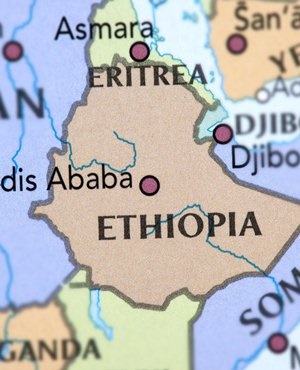Down a sandy track past a desiccated animal carcass lies a cluster of half-built huts that Ethiopia’s government and aid agencies hope will blunt the worsening toll of repeated droughts.
The soon-to-be village of Dabafayed is intended as a new, permanent home for once-nomadic herders made destitute by the country’s back-to-back droughts.
The lifestyle change is drastic but necessary, officials say.
“We can’t talk about a normal state of affairs anymore when drought has become almost perennial,” said Achim Steiner, head of the UN Development Programme (UNDP), during a recent visit to the resettlement site.
If predictions prove correct, Ethiopia will soon face its fourth consecutive year of drought, with the lack of rain hitting pastoralist herders worst.
Robust responses by Ethiopia’s government and foreign aid agencies, and the absence of war, have prevented a repeat of the disastrous famines of the 1970s and 1980s that killed hundreds of thousands.
Ethiopian officials argue the policy of relocating rural communities to areas closer to roads, clinics and schools – known as “villagisation” -drives development, but rights groups say it is forced displacement designed to better control the population.
With competing humanitarian emergency demands the UN and aid agencies are seeking strategies to enable drought-prone areas, such as the southeastern Somali region where Dabafayed is located, to weather the months when water cannot be found.
‘Where will I go?’
Though they have trekked this arid region with their livestock for generations, some ethnic Somali herders say they are ready to settle down rather than face what seems like drought without end.
“You can count on the government, and the NGOs are there giving us assistance,” said Halima Hussein, a resident of a displaced persons camp for herders such as herself whose animals have died of thirst.
“It will be at least better than staying in the bush and herding animals.”
Somali herders can lose everything during drought: from their wealth in the form of animals, to their portable homes, which need pack animals to carry them.
Halima experienced all of this. “We lost our animals. Where will I go back to?” she asked, waiting in line with dozens of other women to draw water from a borehole.
Ethiopia is drought-prone but the Somali region has been badly affected in recent years, forcing aid agencies to last year seek $1.4bn to respond to the water shortage.
Donors pledged all but a fifth of the money asked, but Ethiopia’s humanitarian situation worsened when fighting intensified last September between the Somalis and Ethiopia’s largest ethnic group, the Oromos, killing hundreds and leaving a million homeless.
The UN believes it will need $895m to respond to this year’s drought and Ethiopia’s parliament this month chipped in $182.7m for disaster response, state media reported.
These emergency funds pay for food, water and fodder that keeps people and animals alive, but officials say it ultimately does little to alleviate the privation of drought-hit nomads.
“The climate is changing, there’s more people in this region, and new ways of making a livelihood are going to be needed if we’re going to find a way through this problem,” said Mark Lowcock, the UN’s top aid official.
The Somali region is desperately poor, lacking the economic dynamism of other parts of Ethiopia. The UN says it will assist resettled herders to become farmers.
More than four million people are estimated to live across Ethiopia’s Somali region.
Crisis into opportunity
Aid workers are trying not only to get emergency food to hungry people but to come up with ways to prevent them from starving in the first place.
Beyond just cushioning people from future droughts, the UN’s Ethiopia head Ahunna Eziakonwa-Onochie said the strategy is to offer services such as schools to nomadic communities that were otherwise hard to reach.
“How do we turn a crisis into an opportunity?” Eziakonwa-Onochie said.
“Now that they are forced, actually by the circumstances… into sedentary kinds of lives, we start to see that opportunity to provide education in a more consistent way for the kids.”
The nomadic herder lifestyle is common across Africa and has long defied government attempts to change it.
But Ethiopia spends more time and money exerting control over its people than most, and officials say they believe they can reshape Somali herders.
“If we give pastoralists water and they don’t have to go 50, 100km to find it, is that not good?” said Anwar Ali, humanitarian advisor to the Somali regional state.
“We’re not changing the nomadic lifestyle, we are just improving it.”
Halima is among those eligible to live permanently in Dabafayed. Despite knowing no other life but the nomad’s before the drought took it all away, she’s ready for the change.
“I’m not going anywhere, I don’t have any place to go,” she said. “This will be my permanent arrangement.”
![]()






























